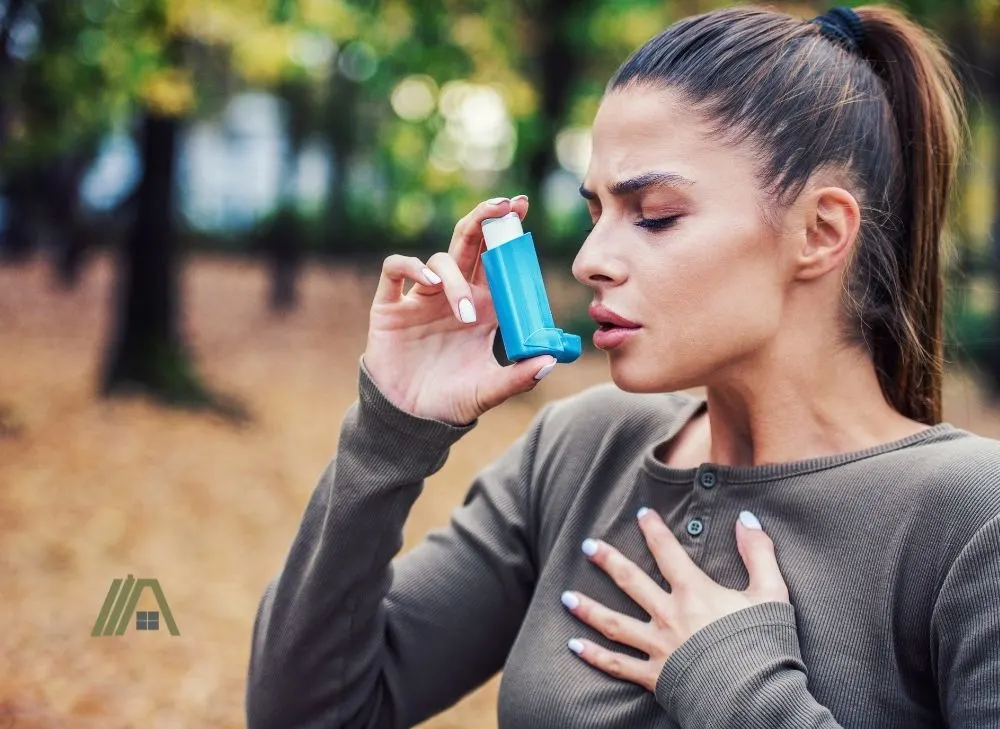The Reme Halo air purifier has been garnering attention, partly due to recent events regarding Covid-19 and partly due to the fascinating technology that it uses. However, the function of this technology involves adding things into the air we breath, which introduces a question regarding safety.
While the Halo is considered safe by federal safety standards, if you’re like me, you want to know the information not just the conclusion so that you can make a personal decision on what’s best for you!

The hydroperoxide ions produced by Reme Halo aren’t a health risk. Ozone, a by-product, can be harmful at certain levels. Ozone levels produced by properly functioning units aren’t enough to affect health. Risk increases if people are vulnerable, ventilation is poor, or other ozone-producing items are present.
What Do Reme Halos Produce/Release?
The Reme Halo is an in-duct air purifier, meaning it is installed inside your ducting system.
In order for these devices to actually purify the air, they produce a hydrogen peroxide plasma, which is a “cloud” of ionized air.
The plasma is dispersed throughout your home via the ductwork, purifying the air by killing contaminants, like viruses and mold spores, and by making allergens big enough to be filtered out of the air.
In addition to the hydro-peroxide plasma, the Reme Halo also produces small amounts of ozone. Ozone is a molecule that is able to react with certain chemicals that cause odors, effectively neutralizing them.
Ozone Is of Most Concern
Of the Reme Halo products, ozone is the concern. Let’s take a look at why exactly ozone can be harmful, and if that’s a problem with the Halo.
Effects of Ozone Exposure
Ozone is made from three oxygen atoms. That would make it seem harmless; we breathe in the diatomic version of oxygen, and what difference could one atom make?
However, that third oxygen in ozone makes the molecule much more reactive with the materials around it.
When these materials happen to be in your body, it’s not a fun time.
Ozone is something we breathe in, so its harmful effects present most commonly as lung-related symptoms.
Exposure often results in shortness of breath, coughing, or throat and lung irritation. It can even cause headaches and nausea.
Moreover, the respiratory tract is supposed to stop germs and irritants from entering the body. When its function is depressed by ozone, it cannot fulfil this role and these germs and irritants get past the body’s natural defences and cause illness.

For those with breathing difficulties or illnesses, their condition may worsen with exposure to ozone.
Long-term exposure and high-concentration exposure to ozone will have worse effects than minimal or short-term exposure.
Quantities Released Are Below Dangerous Levels
The Occupational Safety and Health Administration (OSHA) and the National Institute for Occupational Safety and Health (NIOSH) set the safe ozone exposure limit at 0.1 ppm (parts per million) over an 8-hour period.
The FDA safety levels, however, are only .05 ppm for consistent exposure in an enclosed space (like your home!)
So, how much does the Reme Halo create?
It is difficult to find specific numbers. However, RGF, Reme Halo’s creator, has been open about their products producing small amounts of ozone.
They have been equally open about the fact that their products’ emissions are tested, and that they keep below federal safety levels.
This means that the Reme Halo produces less than 0.05 ppm over a consistent time period.
What Increases the Ozone Risk?
While the Reme Halo does not create enough ozone to be a concern, there are a few factors that could increase the exposure risk.
Bear in mind that the Halo’s output is so small that even these factors may not be enough to cause a problem.
Defective Machines
As with all machines, defects are possible. A dryer may overheat, a toaster might short, and a hair straightener may fail to heat.

In the case of the Reme Halo, it is certainly possible that a faulty device may create an abnormal amount of ozone in comparison to what it is meant to.
Ozone is not easy to identify visibly, however, so it would be hard to tell if a device is over-producing unless you are sensitive to and recognize the smell of it.
If you’re worried about being able to identify high ozone levels, we have a section about measuring ozone below!
Other Ozone-Producing Appliances
In addition to defective Reme Halos, you have other appliances to think about because air purifiers like the Reme Halo aren’t the only devices in your home producing ozone.
If you have many of the following appliances in your home, it’s possible that adding a Reme Halo to the mix could bring ozone levels past the “safe-zone”:
- Laundry water treatment systems
- Fruit and vegetable washers
- Facial steamers.
- Some refrigerators even have their own ozone-making air purifiers.
- Hair dryers (trace amounts).
- Electric fans (trace amounts).
- Office appliances (e.g., copiers and printers).
This news might be reassuring to some who figure the trace amounts created by the Reme Halo are also harmless if they have already been exposed to similar levels without any signs of ill effects.
Others, however, may find the number of potential exposure sources to be worrying.
In general, however, these machines and appliances should be safe if not used in close proximity to each other or all at once, and if they are also all functioning correctly and not over-producing ozone.
You can always decide to research specific items and remove/replace devices that are less important to you so that you can install the Reme Halo with greater peace of mind.
Poorly Ventilated Spaces
Hazards like defective machines and high numbers of ozone-producing appliances are more likely to be a problem when living in a poorly ventilated home.
Poor ventilation could allow the minimal amount of ozone created to build up past safe exposure levels, as it won’t have an “escape route.”
You may not know how well your home is ventilated, but there are a few things that can indicate that your ventilation isn’t sufficient.
Be wary if you’ve ever had sweaty windows or other moist surfaces crop up, regular sewer smells coming from the drain, if your home has ever had a mold problem, or if those living in the home get sick frequently.
If any of these signs seem familiar, you may want to look into your ventilation before deciding to add an air purifier to the mix!
Health Conditions
Many pre-existing health conditions may not mix well with these air purifiers, though that may seem counterintuitive. After all, the Halo is meant to purify the air.
However, while the air purification may be a benefit to some, the additional ozone created may not be beneficial for others, especially if their health conditions are lung-related.
Individuals with asthma, bronchitis, recurring lung infections, lung cancer, or cystic fibrosis may potentially be more sensitive to the ozone that is created, as minimal as it may be.

If you or someone you are living with has a health condition like those listed above, you may want to carefully consider the pros and cons of a Reme Halo and even seek advice from your health practitioner.
Part of this consideration may involve testing the ozone levels in your home beforehand, which we’ll talk about next.
Can You Measure Ozone Levels in the Home?
There are a few ways in which ozone can be measured at home.
The first option works for intermittent monitoring or checking on occasion to ensure that the overall levels have not changed.
This type of occasional check can be done with ozone test strips (amazon link). These work similarly to pH test strips, which you may have come across before.
A more consistent method of monitoring ozone levels is to buy an ozone monitor (amazon link) or ozone detector (amazon link), which work in much the same way a carbon monoxide monitor/detector might.
Be sure to get one that reads below 0 ppm.
While ozone monitors may be more consistent, they are also quite pricey. Depending on what model you go for, one can cost anywhere from $100-400. But depending on your situation, that cost may be worth the peace of mind!
Alternative Option: Reme Halo LED
As an alternative, you can look at the Reme Halo LED.
It is comparable to the Reme Halo in terms of function and the production of hydrogen peroxide ion plasma, but it doesn’t produce ozone.
The reason it does not produce ozone is that it uses a smaller light spectrum to ionize the air. Instead of broad-spectrum UV light (used in the Reme Halo), the Reme Halo LED uses UV-LED, hence the name.
Hydrogen Peroxide
While ozone does help to clean the air, it is technically a by-product.
Hydrogen peroxide is the main substance produced by both the Reme Halo and the Reme Halo LED. Both produce less than 0.02 ppm according to the official specs sheets.
This seems like a very small amount, but in order for it to have meaning, we need to know the allowable limit.
According to OSHA, the limit is 1.0 ppm over an 8-hour period. The 8-hour period is a standard way of measuring exposure limits because these are generally established to protect employees working 8-hour shifts.
However, we can adjust this to see what the allowable limit is for constant exposure. One day is 24 hours. Divide this by 8 hours and you get 3. So, we need to divide the 8-hour exposure limit by 3, which gives us 0.33 ppm.
The hydrogen peroxide concentrations in the air from an operating Reme Halo or LED model are, therefore, well below the limit and do not pose a risk to human health.
Sources
https://www.accessdata.fda.gov/scripts/cdrh/cfdocs/cfcfr/cfrsearch.cfm?fr=801.415
https://airconditioningarizona.com/reme-halo-air-purifier-review/
https://airpurifiers.com/ozone-air-purifier-guide/
https://ww2.arb.ca.gov/resources/fact-sheets/ozone-emissions-consumer-products-study
https://www.cdc.gov/niosh/npg/npgd0476.html
https://www.epa.gov/ground-level-ozone-pollution/health-effects-ozone-pollution
https://www.epa.gov/indoor-air-quality-iaq/ozone-generators-are-sold-air-cleaners#what-ozone
https://homeclimates.com/blog/reme-halo-air-scrubber
https://www.honeywellhome.com/us/en/support/f300-electronic-air-cleaner-2/
https://www.hrv.co.nz/latest/10-signs-your-home-might-not-be-well-ventilated
https://molekule.science/ozone-removal-methods-filters-to-use-in-your-home/
https://www.osha.gov/chemicaldata/9
https://ozonesolutions.com/ozone-safety/
https://www.protechac.com/blog/reme-halo-vs-reme-halo-led/
https://rgf.com/products/air/reme-halo-whole-home-in-duct-air-purifier/
https://www.rgf.com/wp-content/uploads/2017/04/RGF_ASHRAE-Technical-Sales-Bulletin.pdf
